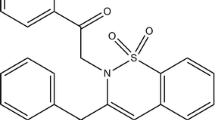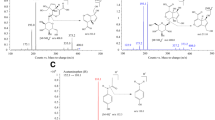Abstract
The present study was designed to investigate the oral bioavailability, metabolism, tissue disposition and excretion of 16α-hydroxycleroda-3, 13(14) Z -dien-15, 16-olide (4655K-09), a novel HMG-CoA reductase inhibitor in male Sprague Dawley (SD) rats. Tissue distribution, oral bioavailability and excretion studies of 4655K-09 were carried out in male SD rats through oral administration at active dose of 25 mg/kg. In vitro metabolism studies were carried out in different rat tissues S9 fractions to evaluate primary organs responsible for conversion of parent 4655K-09 to its major active metabolite K-9T. The quantification of both parent and metabolite in different biological matrices was performed using LC-MS/MS method. The oral bioavailability of 4655K-09 was found to be 30% in male SD rats. The biodistribution study was illustrated in terms of tissue to plasma area under curve (AUC)0−∞ ratio (Kp) revealed the preferential distribution of 4655K-09 and K-9T to target site, i.e. liver. In vitro tissue S9 fraction stability assay demonstrated the rapid and extensive metabolic conversion of 4655K-09 to K-9T, primarily through liver and kidney. Very low amount of parent and metabolite were excreted unchanged in urine and faeces. The present studies established 4655K-09 bioavailability, tissue disposition, excretion and tissue-specific metabolic conversion to K-9T which could assist in its further development as antihyperlipidemic drug.





Similar content being viewed by others
References
Bhatta R, Kumar D, Chhonker Y, Kumar D, Singh SP, Sashidhara KV, Jain G (2012) Simultaneous estimation of 16α-hydroxycleroda-3, 13 (14) Z-dien-15, 16-olide from Polyalthia longifolia and its metabolite in hamster plasma: application to pharmacokinetic study. Biomed Chromatogr 26:559–565
Brown RP, Delp MD, Lindstedt SL, Rhomberg LR, Beliles RP (1997) Physiological parameter values for physiologically based pharmacokinetic models. Toxicol Ind Health 13:407–484
Casey Laizure S, Herring V, Hu Z, Witbrodt K, Parker RB (2013) The role of human carboxylesterases in drug metabolism: have we overlooked their importance? Pharmacother: J Human Pharmacol Drug Ther 33:210–222
Chandasana H, Chhonker YS, Prasad YD, Laxman TS, Anil Kumar K, Dikshit DK, Bhatta RS (2015) Pharmacokinetics and tissue distribution study of novel potent antiplatelet agent S007-867 in mice using HPLC-MS/MS. Xenobiotica 45:530–537
Chandasana H, Chhonker YS, Laxman TS, Prasad YD, KS AK, Dikshit DK, Bhatta RS (2016) Assessement of the pharmacokinetics, tissue distribution and excretion studies of a novel antiplatelet agent S007-867, following administration to rats. Drug Test Anal 8:723–729
Davies B, Morris T (1993) Physiological parameters in laboratory animals and humans. Pharm Res 10:1093–1095
Fan J, de Lannoy IAM (2014) Pharmacokinetics. Biochem Pharmacol 87:93–120
Food U, Administration D (2013) FDA guidance for industry: bioanalytical method validation. US Department of Health and Human Services, Food and Drug Administration, Center for Drug Evaluation and Research: Rockville, MD
Furberg CD, Pitt B (2001) Withdrawal of cerivastatin from the world market. Trials 2:1
Jacobson TA (2006) Statin safety: lessons from new drug applications for marketed statins. Am J Cardiol 97:S44–S51
Kiortsis D, Filippatos T, Mikhailidis D, Elisaf M, Liberopoulos E (2007) Statin-associated adverse effects beyond muscle and liver toxicity. Atherosclerosis 195:7–16
Maron DJ, Fazio S, Linton MF (2000) Current perspectives on statins. Circulation 101:207–213
Parker RA, Clark RW, Sit S-Y, Lanier TL, Grosso RA, Wright J (1990) Selective inhibition of cholesterol synthesis in liver versus extrahepatic tissues by HMG-CoA reductase inhibitors. J Lipid Res 31:1271–1282
Sashidhara KV, Singh SP, Srivastava A, Puri A, Chhonker YS, Bhatta RS, Shah P, Siddiqi MI (2011) Discovery of a new class of HMG-CoA reductase inhibitor from Polyalthia longifolia as potential lipid lowering agent. Eur J Med Chem 46:5206–5211
Sashidhara KV, Puri A, Rosaiah JN (2014) Method of treating dyslipidemia using naturally occurring diterpene. Google Patents
Walker D (1999) Pharmacokinetics and metabolism of sildenafil in mouse, rat, rabbit, dog and man. Xenobiotica 29:297–310
Wyska E, Pȩkala E, Szymura-Oleksiak J (2006) Interconversion and tissue distribution of pentoxifylline and lisofylline in mice. Chirality 18:644–651
Xie M, Yang D, Liu L, Xue B, Yan B (2002) Human and rodent carboxylesterases: immunorelatedness, overlapping substrate specificity, differential sensitivity to serine enzyme inhibitors, and tumor-related expression. Drug Metab Dispos 30:541–547
Yan B, Yang D, Brady M, Parkinson A (1994) Rat kidney carboxylesterase. Cloning, sequencing, cellular localization, and relationship to rat liver hydrolase. J Biol Chem 269:29688–29696
Yeung CK, Fujioka Y, Hachad H, Levy RH, Isoherranen N (2011) Are circulating metabolites important in drug–drug interactions?: quantitative analysis of risk prediction and inhibitory potency. Clin Pharmacol Ther 89:105–113
Acknowledgements
The authors T.S.L and S.P are thankful to the council of scientific & industrial research (CSIR) for providing the research fellowship. The CSIR-CDRI manuscript number of this article is 71/2018/RSB.
Funding
We are thankful to BSC0102 (THUNDER) project for funding and the Director, CSIR-CDRI, for providing facilities and infrastructure for the study.
Author information
Authors and Affiliations
Contributions
The author RSB designed experimental plan and provided necessary facilities. TSL and SKP are performed LC-MS/MS based sample analysis and wrote the manuscript. KVS and SPS synthesized the compound. The author RP, SV, AM and SS are conducted all in vitro-in vivo experiments. YSC analyzed the experimental data. All authors read and approved the manuscript.
Corresponding author
Ethics declarations
Conflict of interest
The authors declare that they have no conflict of interest.
Rights and permissions
About this article
Cite this article
Laxman, T.S., Puttrevu, S.K., Pradhan, R. et al. Pharmacokinetics, metabolism, bioavailability, tissue distribution and excretion studies of 16α-hydroxycleroda-3, 13(14) Z -dien-15, 16-olide—a novel HMG-CoA reductase inhibitor. Naunyn-Schmiedeberg's Arch Pharmacol 391, 965–973 (2018). https://doi.org/10.1007/s00210-018-1518-0
Received:
Accepted:
Published:
Issue Date:
DOI: https://doi.org/10.1007/s00210-018-1518-0




